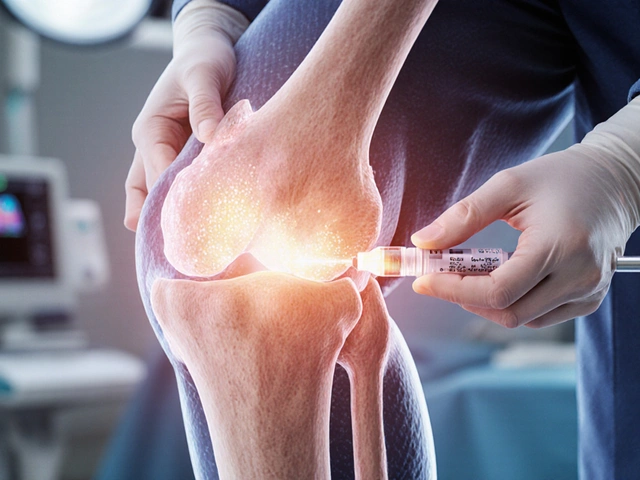When the discomfort of a troubled knee becomes unbearable and daily activities seem like daunting tasks, many turn to total knee replacement as a beacon of hope. This procedure, though daunting at first glance, can restore mobility and significantly reduce pain.
People often wonder about the time they will spend in the surgical theater during a knee replacement operation. Various elements can sway the duration of the surgery—ranging from the complexity of the knee's condition to the specific methods employed by different surgeons.
In the sections ahead, we'll plunge deeper into these intriguing facets and guide you through what to expect before and after your knee meets the skilled hands of modern medicine. A journey to recovery awaits, and knowledge is your trusted companion.
- What Is Total Knee Replacement?
- Factors Affecting Surgery Duration
- Steps Involved in the Procedure
- After Surgery: Immediate Recovering
What Is Total Knee Replacement?
Total knee replacement, often referred to as knee arthroplasty, is a surgical procedure designed to restore function and relieve pain in damaged knees. For many, it becomes a necessary option when knee pain persists despite other treatments. The procedure involves resurfacing the bones that make up the knee joint with metal and plastic components. These artificial parts or prostheses are shaped to allow continued knee movement. The surgery itself has become commonplace, with millions undergoing it successfully every year.
An individual's knee can sustain damage due to arthritis or extensive injury, leading to impaired function and severe discomfort. Osteoarthritis, in particular, is a common culprit that breaks down cartilage, leading to bone-on-bone friction within the joint. Rheumatoid arthritis and post-traumatic arthritis may also necessitate a knee replacement. While the condition of the joint is a primary factor determining if one requires this surgery, other elements such as age, overall health, and activity level also come into play. This procedure remains a beacon of hope for those looking to regain their quality of life.
The Mechanics of a Knee Replacement
The process begins with the surgeon making an incision over the knee to access the joint. The damaged cartilage surfaces at the ends of the femur and tibia are carefully removed. The next step involves resurfacing these bones with metal implants. The patella, or knee cap, is also sometimes resurfaced with a plastic button, depending on the individual case. A spacer, typically made of plastic, is inserted between the metal components to allow for smooth gliding motion. These intricate steps highlight the complexity and precision involved in the procedure.
"Knee replacement is a procedure where we try to mimic natural knee function as closely as possible." — Dr. Richard Berger, Renowned Orthopedic Surgeon
Statistics underline the success and commonality of this surgery. According to the American Academy of Orthopaedic Surgeons, over 90% of individuals who undergo this procedure report a significant decrease in knee pain and an improvement in ability to perform daily activities. This figure speaks volumes about the effectiveness of the surgery and how it aligns with a patient's aspirations for an improved quality of life.
This surgery, although major, is remarkably safe when conducted by experienced experts. As with any surgery, it is not without risks; infection, blood clots, and implant-related issues can occur, yet they are relatively rare. It's essential to discuss these potential risks with your healthcare provider before deciding on surgery. The key takeaway is that this procedure offers a new lease on life for those struggling with severe knee limitations.

Factors Affecting Surgery Duration
When a patient prepares for knee replacement, understanding the intricacies involved can allay anxiety. The varied duration of this procedure often puzzles many prospective patients. Yet, it's fascinating how numerous factors can influence how long one remains under the surgeon's care. Firstly, the complexity of the individual's knee condition is remarkably influential. Knees affected by severe arthritis or deformities may require more time for the operation. Surgeons need surgical precision to address the intricate bone structures, ensuring everything aligns perfectly. Consequently, the more intricate the situation, the longer the process might take to ensure accuracy and safety.
Interestingly, technological advancements in medical practices are reshaping the orthopedic procedure. Hospitals leveraging cutting-edge robotic technology might experience shorter surgery durations since these devices enhance the surgeon's capability to operate with increased precision. This fascinating evolution in tools can dramatically reduce time spent in the operating room without compromising the quality of the surgery. Besides technology, the surgeon's experience also plays a pivotal role. A proficient and seasoned surgeon will often perform the surgery more swiftly, having honed their skills over numerous prior operations. Each decision made during the surgery impacts the timetable, reflecting the surgeon’s experience and intuition.
"A successful operation isn't merely about speed but the harmony of timing and technique," noted Dr. Ana Ruiz, a renowned orthopedic surgeon.
Patient-specific factors can't be overlooked either. A patient's age, weight, and overall health condition significantly influence the surgery's pace. Younger patients with less severe comorbidities often come through in less time compared to older counterparts. They typically have healthier, more resilient tissues, making the operation less complex. Conversely, older patients or those with complicating health issues like diabetes might require additional considerations, adding to the time under surgical lights. Surgeons might pay extra attention during incision and closure phases to ensure proper healing post-surgery for patients with unique medical histories. Finally, anesthesia, a crucial part of ensuring safety and comfort, must be tailored specifically to each patient's needs. This careful calibration can also dictate the surgery’s length.
External Factors
Moreover, external factors, such as hospital infrastructure and scheduling inconsistencies, might stretch out the total time spent from preoperative preparations to postoperative stages. Hospitals boasting state-of-the-art facilities can streamline processes, reducing patient wait times. Nevertheless, unexpected emergencies or even traffic influences on transport for surgeons in big cities can alter expected schedules unpredictably. Such externalities, though minor, do leave their imprint on the timeline involved. Understanding these diverse influences can demystify the process, aid in realistic expectations, and empower patients to engage with their medical journeys more confidently. Whenever planning for a knee surgery, being informed is as crucial as the procedure itself.

Steps Involved in the Procedure
The journey through a total knee replacement procedure is a meticulously orchestrated operation that unfolds step by step. The surgeon must ensure every step is precisely executed to lead to a successful recovery. Before the surgery begins, anesthesia is administered—either general or spinal—based on a conversation about the patient's medical history and preferences, setting the stage for what comes next. The area to be operated on is thoroughly cleansed with antiseptic solutions to curb any infection risks.
The procedure kicks off with an incision over the knee to expose the joint. This incision is usually between six and ten inches long, and made with precision to reduce unnecessary damage. Once the incision grants access, the surgeon moves to remove the damaged cartilage and bone by using specialized instruments. The patella, or kneecap, may be repositioned temporarily to provide a clearer view of the knee components. Orthopedic procedure techniques have evolved greatly over the years to make this a more streamlined process.
This brings us to the next critical phase: preparing the joint surfaces for placement of the artificial components. Surgeons measure and shape the ends of the femur and tibia so that they snugly fit the prosthetic elements. Technology plays a key role here, often involving computer-assisted guidance to ensure accuracy. New metal and high-density plastic come together to recreate the knee joint's surface, specifically selected to withstand body weight and permit fluid movement, benefiting the long-term outcome. Often, skilled professionals ensure proper alignment by inserting a metal stem into the center of the bones.
Once all artificial components are precisely fixed in place—sometimes cemented into the existing bone for reinforcement—the surgeon meticulously closes the incision, employing several layers of stitching to secure it. A drain might be placed temporarily to remove any fluid accumulation, supporting the healing process. For some, the day of surgery ends with a short visit to the recovery room where nurses closely monitor vital signs as the anesthesia fades away.
The American Academy of Orthopaedic Surgeons states, "With over 790,000 knee replacements performed each year, advancements in surgical venues and patient care continue to improve results and speedier recovery times."
Being aware of what takes place inside the operating room during knee surgery not only helps alleviate any apprehensions but also sets realistic expectations about the healing process. The better informed you are, the more equipped you will be to navigate the post-operative phase and embark on the road to recovery. With the structural foundation laid, the body can gear up to embrace renewed activity and freedom from discomfort.

After Surgery: Immediate Recovering
The moment you emerge from the fog of anesthesia, you step into the pivotal phase of immediate recovery after a knee replacement. This period is as crucial as the surgery itself. The hospital environment transforms into a collaborative space where healthcare professionals, from nurses to physical therapists, support your initial steps towards wellness. At first, the knee might whisper discomfort as the body adapts to its new component. Machines around you may beep intermittently—heartbeat watchers, they assure your safe passage through these moments of transition.
During the initial 24 to 48 hours post-surgery, pain management takes center stage. Doctors often employ a mix of medications to handle this aspect. Communication with your medical team is key. They tailor the pain relief plan using your feedback, ensuring it aligns with your unique threshold and needs. It's natural to feel apprehensive about moving the knee so soon, but mobility is vital. Just a day into recovery, physical therapists introduce gentle exercises, cautiously helping you flex that new joint. Gradually, these motions aid in reducing swelling and ward off complications like blood clots.
It's worth noting that the skin staples or stitches sealing your surgical wound require meticulous care to prevent infection. Cleanliness becomes a shared responsibility between you and your caregivers. They might utilize a saline solution for cleaning, explaining each step to empower you with knowledge for after-discharge care. Meanwhile, monitoring vitals ensures that your system is responding well to the new addition of the artificial joint—not forgetting encouragement to partake in deep breathing exercises to fend off pneumonia risks.
"The initial phase of recovery is the most challenging, but with each small step, you regain a fragment of your independence," says Dr. Arjun Patel, an experienced orthopedic surgeon.
Every waking hour may initially seem like a battle against discomfort, but remember, patience is a virtue here. A special pillow could be sandwiched beneath your knee to keep it elevated, helping alleviate swelling. Doctors often recommend the implementation of a cold therapy system to numb the pain and reduce inflation, proving complementary to the prescribed pain medications. And though modest, celebrating minor milestones, such as sitting up or gently using a walker, sets the tone for a hopeful journey ahead.
A myriad of factors can affect this recovery phase, including age, prior health, and the complexity of the surgery itself. Those who were active before surgery might notice swifter improvements compared to those with sedentary lifestyles. Hospitals often provide a table summarizing these differences, helping guide patients on what realistic expectations they should harbor for immediate recovery—recognizing that these stages are the first threads of your new tapestry of movement and health.





